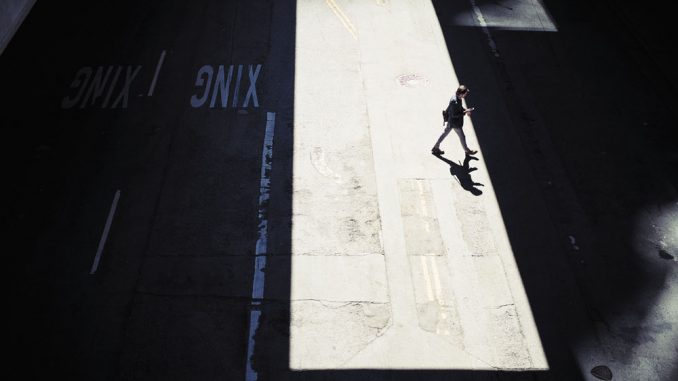
Most people spend their entire day with their head in the clouds, not having the faintest idea of the world around them. They meander down the sidewalk with their eyes on their phones and their ears plugged into music, blind and deaf to everything. Pick-pockets, confidence men, and criminals in general depend on it.
It isn’t that people aren’t concerned with their own safety, they are, but it is a matter of thinking that nothing bad will ever happen to them. It is being complacent in your environment, comfortable in your surroundings and confident that crime only happens in “bad neighborhoods.” Criminals, like lions on the hunt, pick out the weak animal in the herd, the one not likely to fight back. In the human world, it is usually the weak one that lacks situational awareness.

The view might be nice from the upper levels of a parking garage, but the threat will come from somewhere on your side of the railing.
Situational awareness isn’t a practice most people can easily subscribe to, but it affects so much of what you do, from backing out of a parking space to walking through an unfamiliar neighborhood. And best of all, the most important piece of advice in learning to use situational awareness is, simple: Use it all the time.
In general, we are fighting thousands of years of evolutionary adaptation to overcome something our brains have been conditioned to oppose. It is deep in our genetic makeup to quickly identify an immediate threat to our lives, but it is also in our nature to weed out most stimuli our senses receive.
Our brain filters most everything and only looks for sudden changes in our surroundings — quick movements, flashes of color or light — and we are conditioned to react to it. The natural human response to a threat is called “fight or flight.”
Our sympathetic nervous system releases epinephrine and norepinephrine, two hormones that start a chain of physical changes. These hormones increase our heart rate to improve oxygen flow, focus our senses on the threat, and pour glucose into our blood so our muscles will have immediate fuel for maximum performance. This last step literally prepares our bodies to fight or run away.
Situation Awareness Phases
While your body’s reaction to a threat is essential, there are times when there is more than one threat coming from different directions. The problem with the fight-or-flight response is that it creates tunnel vision. Literally, your eyes will zero in on the immediate threat and you will have difficulty comprehending much of the rest of your surroundings, including any additional threats. Fortunately, with some practice, you can counteract this and begin to protect yourself with a wider field of vision. First, it is important to understand how situational awareness works by looking at your perception of a situation.

Perception
The first phase involves observing all the elements in your environment. What do you see? Hear? Even smell? Look for people, objects, their locations, motions, actions and how the entire group and environment are flowing together (or not). Are their movements part of a pattern? Does everything feel normal? For example, in a grocery store, normal customers will be looking for items to buy, pushing their carts or holding various products. Nobody should be running or shouting, and there should be no unusual noises or smells. If so, your brain will perceive something out of the pattern.
Understanding
The second phase is an analysis of what you are perceiving. In the store again, for example, a person is moving erratically, charging toward you in a manner unlike one should in a public setting. In this phase, you recognize the potential threat, interpret the possibilities, and evaluate various outcomes as you see it. The problem is that all of this needs to happen in a split-second. You need to decide whether the person running toward you is indeed a threat and not just someone chasing an errant child not in your line of sight.

In some situations, even taking your eyes off your valuables for a handful of seconds could provide enough time for an opportunistic thief to relieve you of them.
Forecast
If you have a knack for seeing people’s actions and interpreting their eventual outcome, then the forecast phase for you will be most valuable. This stage focuses on taking the information you’ve gleaned in the last few seconds of a situation and deciding on what is likely to happen. Based on that, you will then have to formulate your game plan: fight or flight.
Wherever you are, you need to follow the same three-step process: identify, observe, and prepare for potential threats from people or places. It might mean watching for doorways—especially businesses, if you’re in a commercial area—as possible avenues of escape or safety, as well as watching for threats and recognizing patterns.

Listen to the Little Voice
Each of us has a little voice inside our head, akin to the devil and angel on our shoulders providing us advice. For most people, this little voice is difficult to hear because they have set up a false sense of security or they have completely blocked out stimuli they find upsetting in their lives. However, the little voice is your first line of defense, and it talks to you all the time, announcing when things aren’t right. Interviews of witnesses on the nightly news sometimes start with someone saying, “A little voice told me that something was wrong.” Usually, this is why they are a witness and not a victim, because they listened to their little voice.
Someone knocks on your front door, for example, and your little voice might say, “You’re not expecting anyone. Check it out first before you open.” You look through the peephole and see a disheveled-looking man. The little voice warns: “Don’t open the door.” Start listening to the little voice, especially in situations like this.
Usually, if you have a gut feeling, that internal unsettling knot that we’ve manifested into a physical thing inside our bodies, take note. Pause for a couple of seconds and think before taking any action. You’ve perceived a threat and you’ve understood the situation and are now poised to forecast the outcome. You can open the door and confront the potential threat (it may end poorly for you). You can talk through the door, convincing the potential threat that he should leave. Or you can ignore the knock, say nothing, and hope the potential threat leaves on his own. All of these decisions have consequences based on your awareness of the situation.
Situational Awareness in Reality
Getting in the proper headspace for practicing situational awareness begins before you even leave your home. First, you have made a decision on where you have to go once you’ve left. It is either voluntary — to go to the store or to visit a friend — or involuntary — to go to work or to run an errand. Either way, you are placing yourself in harm’s way. Accidents happen and dangers loom, and you’ve got to be ready for them.

All threats don’t walk on two legs. Assuming you can safely walk across a street without regard to motor traffic because drivers will avoid hitting you is a fallacy that is proven almost daily.
What is an acceptable level of risk you are willing to take to live your life as you see it? Where will you park your car, for example? What kinds of neighborhoods will you visit? Start with a list of criteria for your actions. Park in an open, well-lit area where you can easily view your surroundings. Don’t stay in a bad neighborhood longer than you have to and leave before nightfall. Having a mental set of actions to take if threatened or attacked is paramount.
“Getting in the proper headspace for practicing situational awareness begins before you even leave your home..”
More important, keep a vigilant eye open on everything around you. Could someone be hiding in that dark alley? Of course. Is that guy reaching for a knife in his waistband? Maybe. Is that a Russian agent with a dirty bomb in his briefcase? Not likely, but at least you’re being observant.

There is nothing wrong with giving newcomers a quick, if not discreet, once-over when they enter the space you’re in.
Practice Makes Perfect
The best way to increase your situational awareness skills is to simply observe your surroundings, especially in large groups of people. This gives you an opportunity to notice unexpected motions and actions and other breaks from “normal” patterns of a group of people. It teaches you to scan and recognize people whose actions differ from their surroundings. And when given the opportunity, you can even forecast those actions and avoid bumping into people or accurately guess the outcome of a person’s walking pattern or actions. With this exercise, it is a harmless way to see the fluid dynamic of a group of people with little chance of danger. EDC
Editor’s note: A version of this article first appeared in the EDC Buyer’s Guide Winter, 2020 print issue of American Survival Guide.





Be the first to comment